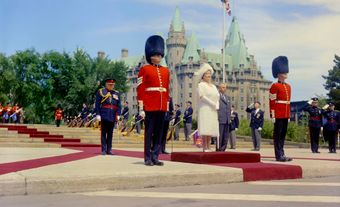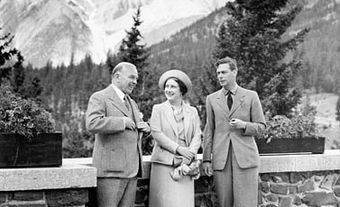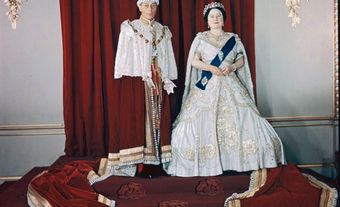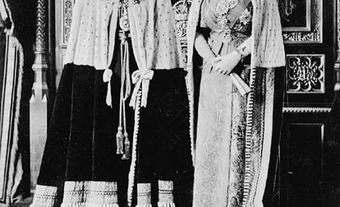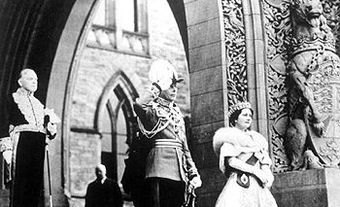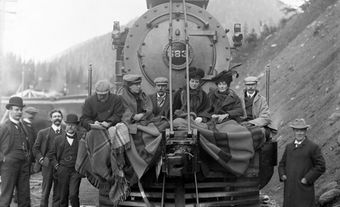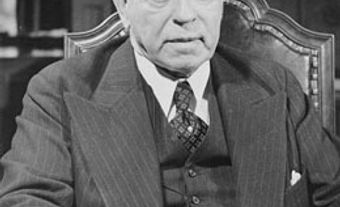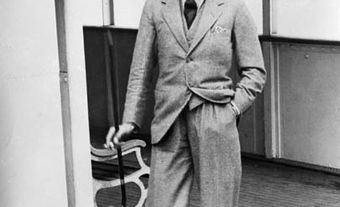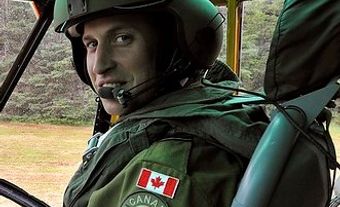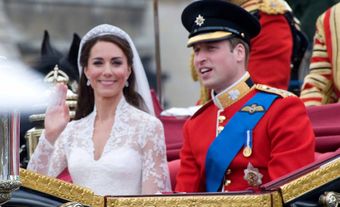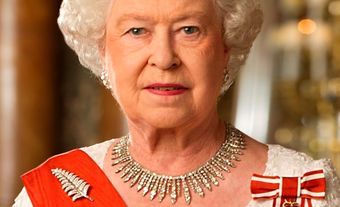
Albert and Elizabeth
The future King George VI was born on 14 December 1895. At the insistence of his great-grandmother, Queen Victoria, he was named Albert after his great-grandfather, who died on the same day in 1861. As the second son of the future King George V, the young prince was not expected to succeed to the throne and instead trained for a naval career. At 17, he visited Canada for the first time on a six-month training cruise in 1913.
In 1930, the Canadian government requested that the Prince, who had become Duke of York in 1920, be chosen as Governor General. The British government decided against this because of the changing relationship between the United Kingdom and Canada — including Canada’s growing autonomy — soon to be enacted under the Statute of Westminster.
In 1923, the Duke of York married Lady Elizabeth Bowes-Lyon, the ninth of the 10 children of the Earl and Countess of Strathmore, members of the Scottish aristocracy. The wedding and the arrival of the royal couple’s two daughters, the future Queen Elizabeth II(born 1926) and Princess Margaret (1930–2002), attracted public interest throughout the English-speaking world, including Canada. (When her daughter succeeded to the throne in 1952, Elizabeth became known as the Queen Mother.)
On 20 January 1936, King George V died and was succeeded by the Duke of York’s older brother, who became King Edward VIII. Almost a year later, Edward VIII abdicated to marry Wallis Simpson, a twice-divorced American socialite. The Duke of York became King as a result of the Abdication Crisis and assumed the name George VI to symbolize continuity with the reign of his father, George V.
King and Queen of Canada
In 1931, the Statute of Westminster granted Canada control over its own foreign policy. The Statute changed the relationship between Canada and the monarchy, creating a distinct Canadian Crown. Canada became the political equal of the United Kingdom, sharing a common monarch. The Governor General’s position transformed from representative of the British government to representative of the shared monarch alone. King George VI and Queen Elizabeth therefore toured in 1939 as King and Queen of Canada.
Lord Tweedsmuir, Governor General from 1935 to 1940, extended the invitation to the royal couple to visit Canada after a planned tour of India was cancelled in 1938. Tweedsmuir met with George VI on 24 September 1938 at Buckingham Palace, where the King confirmed the historic trip to Canada. The itinerary was published in newspapers on 4 January 1939. The threat of the Second World War influenced preparations. Queen Elizabeth later recalled, “We were going [to go to Canada] in a battleship and had to change to a liner in case [the warship] was wanted. It was as close as that.”
Canada by Train
The King and Queen spent a month in Canada, touring the country from 17 May to 15 June (excluding four days in the United States from 8 to 11 June). They crossed the country twice in a blue and silver royal train that became the most recognizable symbol of the tour. The tour began in Quebec City when the royal couple arrived on the Canadian Pacific liner Empress of Australia escorted by two destroyers and two cruisers of the Royal Canadian Navy. Prime Minister William Lyon Mackenzie King formally welcomed the couple with a speech that included the words, “Today as never before the throne has become the centre of our national life.”
The westbound journey included stops in Trois-Rivières, Montreal, Ottawa, Kingston, Toronto, Winnipeg, Regina, Calgary, Banff, Vancouver and Victoria, as well as numerous small towns and villages. The train then travelled east, stopping, among other places, in Jasper, Edmonton, Saskatoon, Sudbury, Guelph, Kitchener, Windsor, Hamilton, St. Catharines and Niagara Falls. After the visit to the United States, the royal couple returned to Canada and continued their tour through Rivière-du-Loup, Fredericton, Saint John, Moncton and Charlottetown before departing by ship from Halifax. Before returning to Britain, the royal couple sailed to St. John’s, capital of the separate Dominion of Newfoundland at the time.
Mackenzie King welcomed the royal couple at every stop on the tour. George VI gave royal assent to nine bills and became the first Canadian monarch to directly meet his Parliament. He and Elizabeth also dedicated the National War Memorial in Ottawa and laid the cornerstone on the new Supreme Court of Canada building then under construction.

First Royal Walkabout
The now-familiar royal walkabout, where members of the royal family meet and greet crowds of citizens during their tours, was spontaneously born in Ottawa in 1939. After dedicating the National War Memorial on 21 May, the royal couple, instead of returning to their motorcade immediately afterward, spent half an hour mingling with the 25,000 First World War veterans who were part of a crowd of at least 100,000 people. It was a stunning gesture, especially in an age when members of the royalty were often perceived as distant figureheads. A CBC radio announcer covering the event observed the warm rapport between the royal couple and the crowd: “One these old veterans is patting the King most affectionately on the shoulder…Her Majesty is chattering with one of the veterans of the amputations association…The Queen is speaking to a blind veteran now…The King is shaking hands….”
Tweedsmuir, who was also there, recognized the lasting impact of the walkabout on the eve of the Second World War: “One old fellow said to me, ‘Aye, man if Hitler could just see this.’ It was wonderful proof of what a people’s King means.”
Great Spectacle
The King and Queen were greeted by enormous crowds throughout the tour. The CBC described the reception as “a majestic mayhem.” Millions of Canadians gathered in cities, towns and rural railway crossings to see the royal couple or to simply watch the train pass through areas where no stop was scheduled. The enthusiasm was shared by Canadians of all backgrounds. In Quebec, prior to the Quiet Revolution of the 1960s, the Crown was viewed as a protector of minority rights within the larger democracy and the royal couple was well received by French Canadians. Queen Elizabeth wrote to her daughter, the future Queen Elizabeth II, “The French people in Quebec and Ottawa were wonderfully loyal; & [in] Montreal there must have been 2,000,000 people, all very enthusiastic & glad to have an excuse to show their feelings. Yesterday in Toronto it was the same….”
The King and Queen gave speeches in both French and English. While the King still suffered from a mild stammer when giving speeches in English, he did not suffer the same impediment in his French addresses.
In his journals, Mackenzie King also made frequent mention of the enthusiastic crowds at every stop. For example, when the royal train reached Brandon, Manitoba, there was “wonderful cheering. A long bridge overhead crowded with people. The hour: 11 at night.”
French Canadian Responses
The enthusiastic response to the royal tour in Quebec was influenced by the views of French Canadian political and religious leaders. Two French Canadian cabinet ministers, Ernest Lapointe and Fernand Rinfret, encouraged public interest in the tour. Camillien Houde, the mayor of Montreal, ensured that Montreal spent more money on royal tour events than Toronto. Cardinal Jean-Marie-Rodrigue Villeneuve, archbishop of Quebec, had met King George V and supported the monarchy. At the time, the Roman Catholic school system in Quebec taught that the British conquest of Quebec had protected the region from the secular influence of the French Revolution.
The presence of the King and Queen in Quebec received extensive press coverage, and Quebec tourism increased by 65 per cent in the aftermath of the tour. French-language newspapers emphasized that French Canadians were loyal to the Crown and admired the royal couple on a personal level but did not support British imperialism or view themselves as having assimilated into the British Empire. La Presse criticized the displays of British flags and decorations in Quebec as “imperialistic propaganda” and instead placed the royal tour in a French Canadian context, stating, “Why don’t we, French Canadians, profit from the occasion to manifest our loyalty and attachment to our sovereigns, certainly, but also to our language, our nationality, our rights, our ethnic character. If we must have inscriptions, let them be worded in French, if we cheer, cheer in French….”
American coverage of the royal tour assumed that Quebec was comparatively indifferent or hostile to the presence of the King and Queen in the province. Both Time and Life magazines reported that the royal couple had travelled in bulletproof limousines in Quebec City and Montreal for security reasons without mentioning that the royal couple would use the same kind of vehicles at other stops across Canada. Quebec commentators objected to the implications of this coverage. Le Devoir declared, “The only gangsters or gunmen we have come to us from the US” and compared the fine French cuisine that the King and Queen had enjoyed in Quebec to the “hot dogs or peanut butter sandwiches” that the royal couple might receive in the United States.
Media Coverage in English Canada
Coverage of the 1939 Royal Tour was extensive in both Canada and the wider world. CBC Radio sent a staff of 100 to cover the tour, and newspapers reported extensively on the events. The tour provided the impetus for inaugurating a Canadian shortwave broadcasting service. There was an international press corps as well, which also travelled on the royal train.
Queen Elizabeth wrote to her mother-in-law, Queen Mary: “In Ottawa, we had a reception for all the journalists who are travelling with us on the pilot train — about 80 of them! The Americans are particularly easy and pleasant, and have been amazed I believe at the whole affair. Of course, they have no idea of our Constitution or how the monarchy works….”
There were a few mishaps in the media coverage, including a Winnipeg radio announcer who swore on the air during his live commentary after becoming tongue-tied trying to describe the reception of the King and Queen by Mackenzie King and Winnipeg mayor John Queen.
American Visit
In the midst of their Canadian tour, the royal couple spent four days in the United States, which included a visit with US president Franklin Delano Roosevelt at his private residence at Hyde Park in New York and in Washington, DC. The royal couple visited the British and Canadian pavilions at the 1939 New York World’s Fair and enjoyed a picnic lunch of hot dogs with the Roosevelts.
The King and Queen developed a strong rapport with Franklin and Eleanor Roosevelt, which lasted throughout the Second World War. Queen Elizabeth recalled decades later that the American visit “was very valuable because the King was able to talk to Roosevelt. Endless night talks they had, because Hitler was looming then.”
“Canada Made Us”
Although the original purpose of the 1939 tour was to allow the monarch to engage with Canadians as King of Canada, the impending outbreak of war shaped the significance of the event. Queen Elizabeth alluded to the threat of war in her thank you letter to Lady Tweedsmuir, stating, “Our chief emotion is one of deep thankfulness that [the tour] was such a success, for more & more one feels that a united Empire is the only hope for this troubled world of today.”
The separation of British and Canadian foreign policy in the Statute of Westminster meant that Canada did not automatically declare war on Germany along with the United Kingdom. The tour, however, renewed ties between Canadians and Britain, helping to ensure support for joining Britain in its war effort. On 10 September 1939, Mackenzie King advised George VI to declare war on Germany in his capacity as King of Canada — just one week after the United Kingdom had made its own declaration.
For Queen Elizabeth, the 1939 tour began a 50-year personal relationship with Canada that helped establish her and her husband as a modern royal couple and set precedents for future Canadian royal tours. She would say later that “Canada made us.” Her great-grandson Prince William, The Duke of Cambridge, repeated this sentiment in 2011 at the conclusion of his first royal tour in Canada with his wife, Catherine, The Duchess of Cambridge. As the Queen Mother, Queen Elizabeth visited Canada 14 times and became a patron of numerous Canadian charities and honorary colonel-in-chief of Canadian military regiments. In 2000, the Queen Mother was appointed to the Order of Canada at the age of 100.

 Share on Facebook
Share on Facebook Share on X
Share on X Share by Email
Share by Email Share on Google Classroom
Share on Google Classroom

